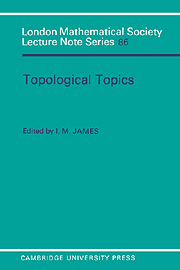 Topological Topics
Topological Topics Book contents
- Frontmatter
- Contents
- Publications of P.J. Hilton
- Essay on Hilton's work in topology
- The work of Peter Hilton in algebra
- The dual Whitehead theorems
- Homotopy cocomplete classes of spaces and the realization of the singular complex
- Betti numbers of Hilbert modular varieties
- Homotopy pairs in Eckmann-Hilton duality
- Profinite Chern classes for group representations
- Automorphisms of surfaces and class numbers: an illustration of the G-index theorem
- The real dimension of a vector bundle at the prime two
- Maps between classifying spaces, III
- Idempotent codensity monads and the profinite completion of topological groups
- Finitary automorphisms and integral homology
- Finite group actions on Grassman manifolds
Maps between classifying spaces, III
Published online by Cambridge University Press: 07 December 2009
- Frontmatter
- Contents
- Publications of P.J. Hilton
- Essay on Hilton's work in topology
- The work of Peter Hilton in algebra
- The dual Whitehead theorems
- Homotopy cocomplete classes of spaces and the realization of the singular complex
- Betti numbers of Hilbert modular varieties
- Homotopy pairs in Eckmann-Hilton duality
- Profinite Chern classes for group representations
- Automorphisms of surfaces and class numbers: an illustration of the G-index theorem
- The real dimension of a vector bundle at the prime two
- Maps between classifying spaces, III
- Idempotent codensity monads and the profinite completion of topological groups
- Finitary automorphisms and integral homology
- Finite group actions on Grassman manifolds
Summary
Introduction. Let G' and G1 be compact connected Lie groups, and let f: BG → BG' be a map. It is shown in [2] that the induced homomorphism f*: K(BG) ← K(BG') carries the representation ring R(G') ⊂ K(BG') into the representation ring R(G) ⊂ K(BG). Moreover the induced map R(G) ← R(G') can also be induced by a homomorphism θ: T → T', where T,T' are the maximal tori in G,G'. Here of course one has to state that the behaviour of θ with respect to the Wey1 groups W,W' is such that θ*: R(T) ← R (T') does indeed carry R(G') ⊂ R(T') into R(G) ⊂ R(T); in [2] maps θ with this behaviour are called “admissible maps”.
Our present purpose is to see what further information can be obtained by using real and symplectic K-theory. Let RO(G) ⊂ R(G) be the subgroup generated by real representations; similarly for RSp(G) ⊂ R (G), using symplectic representations. Assume that the group G is semi-simple.
Proposition 1.1. For any map f: BG → BG', the induced homomorphism R(G) ←R(G') preserves real elements, in the sense that it carries RO(G') into RO(G); similarly it preserves symplectic elements, in the sense that it carries RSp (G') into RSp(G).
The main problem, however, is to take this result and deduce useful, explicit conclusions about θ: T → T'. For this purpose we must recall some representation-theory. In particular, if ρ is any irreducible (complex) representation of G, then under ρ any element z in the centre Z of G acts as a scalar.
- Type
- Chapter
- Information
- Topological TopicsArticles on Algebra and Topology Presented to Professor P J Hilton in Celebration of his Sixtieth Birthday, pp. 136 - 153Publisher: Cambridge University PressPrint publication year: 1983


